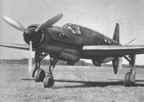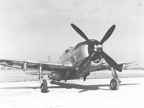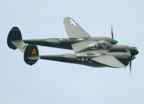|
Before Jets-The Last and
Hottest Piston Engine Fighters
Outstanding Piston PLanes
by Wallace Wood
Click images with the red star
for a larger view
|
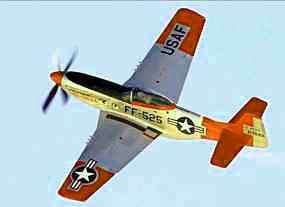
P-51 Mustang |
World War II was the time of the
prop-driven planes. Some of the greatest piston engines ever built
for aircraft were seen in the air toward the end of that terrible
war. And they powered some of the greatest aircraft. Bar arguments
(and fights) can start on which was "the greatest" of all.
But we can probably agree many now-forgotten airplanes and engines
were in the general category.
|

Macchi MC200 Thanks to
(Corner of the
Sky) 
|
The Italians' Macchi MC200 fighter was no slouch, either.
But its memory is lost next to other more famous planes. |
|
F8F Bearcat Not so long ago, the American "Rare
Bear" Grumman F8F Bearcat set the fastest piston aircraft
record at 528 mph in 1989.
|
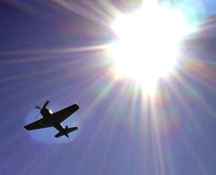 BearCat Flys again in 2003 and Kilroy
Was There! click the star
BearCat Flys again in 2003 and Kilroy
Was There! click the star  |
|
|
Do-335 "Pfeil"
But the German's twin engine (front and rear) Dornier Do-335
"Pfeil" (Arrow) set the "fastest" record
back in 1945 at 472 mph in level flight. In 1945 the Bearcat's
top speed was listed at 420 mph at 28,700 feet. A lot of Bearcats
were built, but only 14 Pfeils.
|
|
Hawker Tempest It
wasn't official, but the British claimed 477 mph for their prototype
V-1 flying bomb chaser, the Hawker Tempest. Squadron Leader
Roland Beamont calmly talked of 480 mph buzzing his airfield
at 20 feet off the ground in the production version. One of
the most powerful and advanced piston engines ever built, the
2,250 cubic inch Napier Sabre pulled the Tempest
|

Hawker Tempest Thanks to The
Hawker Tempest Page 
|
along with 2,250 horsepower
to start with, eventually upped to over 3,000 hp. Its in-flight
sound is closer to a wolverine's howl than a roar. The Napier Company
made record-breaking speedboat and automobile engines before turning
to aircraft.
The Tempest's problem was that it
wasn't a high-altitude engine and was sensitive to dirt. Top performance
was well under 25,000 feet. But lower down, it was a fearsome beast,
which could and did shoot down the German jet fighter, the Messerschmitt
Me-262 as well as the most V-1 'buzz bombs' of any British aircraft.
German jet pilots said it was the only enemy plane they respected.
Later Tempests got a 2,500 hp air-cooled radial engine, the Centaurus,
and lost the big "chin" for the front radiator in the water-cooled
Napier.

 Hawker Typhoon Thanks to Probert
Encyclopaedia
Hawker Typhoon Thanks to Probert
Encyclopaedia |
Hawker Typhoon
Typhoon It was a family resemblance. The Tempest's "father"
was a big-chin look-alike called the Typhoon. The 'Tiffy' had
fat wings and a weak tail which tended to pull off from vibration
in a dive. But the slower 'Tiffies' destroyed 135 tanks in the
D-Day Invasion at Normandy in June of 1944 and were much beloved
by the British.
|
|
Ta-152 The German
Lufwaffe (air corps) "long-nosed Focke-Wulf 190",
the Ta-152, was clocked at 463 mph. Like the "Arrow,"
only a few were manufactured.
|
|
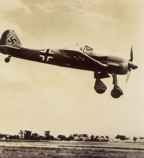 Focke-Wulf 190 Thanks to Chicago Centennial
of Flight Commision
Focke-Wulf 190 Thanks to Chicago Centennial
of Flight Commision  |
The F-W 190 itself
is in competition for best fighter of the war. Over 4,000 were
made. It wasn't heavy, it was well armed with both cannon and
machine guns, it was fast on the climb and dive and very maneuverable
and tough. It could carry bombs and rockets. The '190 was a
much-respected aircraft among American and British pilots. The
"normal" '190 could top out about 420 mph with emergency
engine boost.
|
|
P-51 Mustang Most famous of American
WWII aircraft was the U.S.-built P-51 Mustang, a long-lived
design used even in the Korean War and beyond. It would "only"
do about 440 in its most extreme version with the British-designed
Rolls-Royce "Merlin" engine. But it could fly nearly
1,000 miles from Britain to Berlin with the bombers, fight the
German planes, and fly back. The only fighter that could do
that. And a lot of Mustangs were built.
|
|
North American Aviation built the Mustang for the Brit's in 117 days
from drawing board to tarmac to beat a 120 day deadline. Without an
engine. It was an omission with portent.
When the British replaced the U.S. Allison engine in the Mustang with
the V-12 'Merlin', it was transformed from a fast medium-altitude
performer to perhaps the greatest WWII fighting plane at high altitudes.
Subject to argument, but the Mustang became the "Cadillac of
the Air."
|
P-47 Thunderbolt Nearly as famous
was the P-47 Thunderbolt, one of the heaviest single engine
fighters ever built. Affectionately known as "The Jug"
(for Juggernaut), it had the most powerful U.S. designed engine
at the time, the Pratt & Whitney 2,000 hp air-cooled radial.
The Jug's propellers covered 12 feet top to bottom. Its supercharger
made sure the horsepower was there at high altitudes of 30,000
feet or more, something that could not be said of lesser aircraft.
The Jug' took awhile to pick up speed climbing
|
|
or on the flat, but could reach 420. When it threw its weight into a
dive, look out! Jug' pilots complained of a lot of buffeting and had
trouble pulling out of a steep dive. Some weren't around to complain.
They were on the edge of the speed of sound. The Jug' had something else going
for it: eight .50 caliber machine guns (compared to four for the first
Mustangs). When those .50's let loose all at once, they could and
did knock railroad engines off the track. Armed with rockets and bombs,
the Jug' was even better at ground support than air combat-and it
wasn't bad at air combat. It was tough as old shoe leather and hard
for even German cannon shells to bring down.
|
|
P-38 Lightning
Another famous U.S. aircraft was the P-38 "Lightning"
made by Lockheed. This unusual plane had cannon of its own as
well as four .50 caliber guns, twin Allison engines, and could
carry bombs and rockets. Bigger than even the Jug', the Lightning
was surprisingly nimble and pilots had a few special tricks during
'turning contests' with the Messerschmitts and Japanese Zeroes.
One was called the "hammerhead" and describing it is
beyond my skill.
Lightning pilots could reach 414 mph and high altitudes-40,000
ft. |
| Used throughout the Second World War,
the P-38 is remembered for shooting down the Japanese plane carrying
the brilliant Admiral Yamamoto, the man who planned Pearl Harbor
but lost the |
Battle of Midway. Later in the war the Lightning was
overshadowed by more advanced aircraft, but the record of the "fork-tailed
devil" as the Germans called it was sparkling, especially in
the Pacific theatre. U.S. aces of aces Richard Bong flew a P-38, with
40 victories. See
The Glacier Girl Flies again! Pulled from below tons of ice,
she was restored and flies!
|
Zero As a general
rule, Lightning pilots and all Allied pilots were better off
not trying to dogfight the very nimble and capable Zero. Better
to "boom and zoom" through any formation of Zeroes,
and not hang around to see who could outturn who. The Zero's
top speed was only 356 mph, but deserves to be on the "best"
list of WWII aircraft. It saw great service in every role
for Japan in that war, including carrier aircraft. The Zero's
weakness was lack of armor and self-sealing fuel tanks. The
planes tended to burn and blow up very easily when hit with
cannon or tracer bullets.
|
|
|
|
Ki-84 Japan's other
outstanding aircraft is seldom mentioned. The U.S. code designation
for it was the "Frank". It was the Nakajima-engined
Ki-84, and its name, Hayate, means "hurricane."
The Frank fought against Claire Chennault's Flying Tigers
in China before the U.S. officially entered the war, and his
P-40's did everything they could to avoid contact. The 18-cylinder
air-cooled
|
engine peaked at 1,800 hp or over 1,900 hp depending on who you read,
and the Frank could do 388 mph., a very high speed that early in the
war. It had .20mm and later .30 mm cannon. Such shells are over an
inch thick. Some 3,500 Ki-84's were built. Luckily for the Allies,
their capture or destruction of strategic materials isolated Japanese
industry. The special metals required for the Ki-84 were in short
supply, and Ki-84 pilots found many things that didn't work after
they took off, including the landing gear. British readers will be annoyed at
the long delay in mentioning their favorites, but we've saved some
of the best for last.
| Spitfire.
The name itself is synonymous with the Battle of Britain. Graceful
elliptical wings let it turn like a Zero; well, almost as good.
The same Merlin engine that powered the P-51 Mustang powered the
Spitfire. It was quick and it was fast. Developed from a racing
plane design by Supermarine Company, the Spitfire was dismissed
as a "sport plane" by German engineers. But the Spit'
was the equal of the Germans' main fighter, the battle-tested
Messerschmitt |
|
Me-109. Differences between the
two was a matter of tactics and pilot skill.
At first, the Spitfire was slightly under-gunned with eight .303 calibre
weapons against the .20mm cannon and machine guns of the '109. Cannon
were added later to the Spit's growing list of tools.
If the Spit
pilot chased an Me-109 in a dive, the "negative gravity"
starved the carburetor and the engine would cut out. Like astronauts
training for zero "g" in the "Vomit Comet", the
gasoline would float up and away. Engineers thought the carb' gave
more horsepower than fuel injection. Maybe. But this was not a popular
side effect with British pilots. Germans thought it was a fine idea
as they raced away from a sputting Spit'. The Spitfire pilots learned
to flip over and start their dive upside-down.
Enter the
inventive Miss Tilly Shilling, a racing motorcyclist and engineer
at the Royal Aircraft Establishment at Farnborough. She had a metal
plate with a small hole put in the carb' so all the gasoline couldn't
float away at once in a dive. Of course this was known as "Miss
Shilling's orifice", and allowed negative 'g' flying for a while.
Intake port fuel injection (like most cars have today) was added later.
|

Hawker Hurricane Thanks to Post-war
Military Aviation, Vic Flintham 
|
Hawker Hurricane Two
other aircraft beloved of the British had Rolls-Royce Merlins.
One was the part wood, part metal Hawker Hurricane, made by
the same company that built the Typhoon and the Tempest. It
was the first English fighter to top 300 mph. Hurricanes got
less powerful engines and couldn't match the 357 mph of the
first Spit's in the Battle of Britain. Both got stronger engines
later. Hurricanes had two advantages: being half wood and fabric
like the old biplanes, they absorbed a lot of damage and were
easy to repair. And they could out-turn even the graceful Spitfire.
|
While the faster Spitfires tangled
with the Me-109's, the Hurricanes went after the German bombers. There
were only 620 Spits' and Hurricanes facing what some say were over
2,500 and others say 3.500 German aircraft in the Battle of Britain.
Hurricanes accounted for more "kills" than any other British
aircraft. By war's end, 14,500 Hurricanes were built and used in every
conceivable way-as fighter-bombers, tank busters, and so on. These
were called "Hurribombers".

Wallace Wood (no relation to the famed Mad Magazine
cartoonist) is a San Jose State University journalism graduate.
He worked for the San Jose Mercury/News as a stringer, then
briefly for the Sunnyvale Standard/Mt.View Register-Leader (now
defunct) before spending years at the Santa Cruz Sentinel. All
California papers. He is now "retired".
A series of his on paper subdivisions won third place in Associated
Press competition for the tiny Sentinel statewide behind two
L.A. Times writers. But another series on the business of death
at funeral homes had greater impact, leading to many self-imposed
reforms in the industry. |
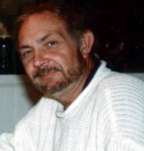
Wallace Wood
Click image for a larger view |
See the latest! This time about the
YAK-9 Click the star . . . 
See the Australian entry in the fastest plane . . . . . . . . . .
. . . 
Send Corrections, additions, and input to:
WebMaster/Editor


|




